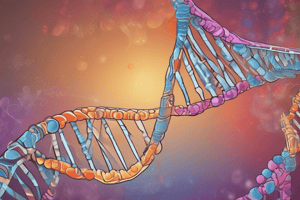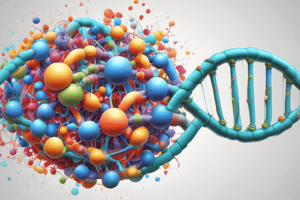Podcast
Questions and Answers
ដំណាក់កម្មវិធីបញ្ចូលមូលដ្ឋានរបស់ DNA មានដំណាក់កម្មប៉ុន្មានជាង?
ដំណាក់កម្មវិធីបញ្ចូលមូលដ្ឋានរបស់ DNA មានដំណាក់កម្មប៉ុន្មានជាង?
- ៤
- ៣ (correct)
- ៥
- ២
អ្វីជាការបង្កើតមូលដ្ឋានរបស់ DNA ដែលមានដីមានតែមួយគឺជារបស់ចាស់ហើយមួយគឺជារបស់ថ្មី?
អ្វីជាការបង្កើតមូលដ្ឋានរបស់ DNA ដែលមានដីមានតែមួយគឺជារបស់ចាស់ហើយមួយគឺជារបស់ថ្មី?
- របស់អនាគត
- របស់បច្ចុប្បន្ន
- របស់ដើម (correct)
- របស់កម្មវិធីបន្ទាប់
អ្វីជាគ្រឿងផ្សំដែលផ្សំគ្នានៅក្នុងមូលដ្ឋាន DNA?
អ្វីជាគ្រឿងផ្សំដែលផ្សំគ្នានៅក្នុងមូលដ្ឋាន DNA?
- A-T និង G-C (correct)
- A-T និង C-G
- A-G និង T-C
- A-C និង G-T
ដំណាក់កម្មវិធីសរសេររបស់ DNA ត្រូវបានចាត់ទុកដោយដំណាក់កម្មប៉ុន្មានជាង?
ដំណាក់កម្មវិធីសរសេររបស់ DNA ត្រូវបានចាត់ទុកដោយដំណាក់កម្មប៉ុន្មានជាង?
អ្វីជាការបង្កើតមូលដ្ឋានរបស់ DNA ដែលមានការផ្សំដោយវិធីសរសេរ?
អ្វីជាការបង្កើតមូលដ្ឋានរបស់ DNA ដែលមានការផ្សំដោយវិធីសរសេរ?
អ្វីជាដំណាក់កម្មវិធីដែលបង្កើតមូលដ្ឋាន RNA ពីមូលដ្ឋាន DNA?
អ្វីជាដំណាក់កម្មវិធីដែលបង្កើតមូលដ្ឋាន RNA ពីមូលដ្ឋាន DNA?
Flashcards are hidden until you start studying
Study Notes
Replication
- Process: DNA replication occurs in three stages: initiation, elongation, and termination.
- Initiation: The process begins with the unwinding of the double helix at a specific region called the origin of replication.
- Elongation: An enzyme called helicase unwinds the DNA, and another enzyme called primase adds short RNA primers to the template strands.
- Termination: The process is completed when the replication forks meet, and the new DNA molecules are formed.
- Semi-conservative: DNA replication is semi-conservative, meaning that each new DNA molecule contains one old strand (template) and one new strand synthesized during replication.
Structure
- Double Helix: DNA is a double-stranded molecule shaped like a double helix, where two complementary strands are twisted together.
- Nucleotides: DNA is composed of nucleotides, which are the building blocks of DNA. Each nucleotide consists of a sugar molecule, a phosphate group, and one of four nitrogenous bases: adenine (A), guanine (G), cytosine (C), and thymine (T).
- Base Pairing: The nitrogenous bases pair in a specific manner: A-T and G-C.
- Hydrogen Bonding: The base pairs are held together by hydrogen bonds, which are weak chemical bonds between the nitrogenous bases.
Transcription
- Process: Transcription is the process of creating a complementary RNA copy from a DNA template.
- Initiation: Transcription begins with the binding of an enzyme called RNA polymerase to the DNA template.
- Elongation: RNA polymerase reads the DNA template and matches the incoming nucleotides to the base pairing rules (A-T and G-C).
- Termination: Transcription is completed when the RNA polymerase reaches the termination sequence, and the RNA transcript is released.
- Types of RNA: There are three main types of RNA produced during transcription: messenger RNA (mRNA), transfer RNA (tRNA), and ribosomal RNA (rRNA).
Studying That Suits You
Use AI to generate personalized quizzes and flashcards to suit your learning preferences.




